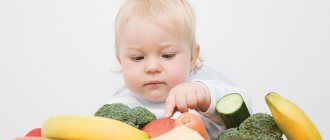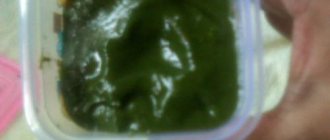Most babies are ready to try something other than breast milk or formula by the age of five months. When the baby has grown to complementary feeding, parents face a bunch of questions that we will try to answer in this article.
Many pediatricians recommend introducing complementary foods into a child's diet starting at 5 months . What can be given to such a small child to taste, and what to avoid like fire - the main question for parents of 5-month-old babies. To see a smiling baby, you should provide him with proper nutrition. Let's figure out what kind of diet a child needs at this age.
Baby's diet at 5 months
At 5 months, the child still receives basic nutrition in the form of mother's milk. During this period, you can also add a few spoons of vegetable puree. You need to feed your baby 5 times a day - every 4 hours.
Many pediatricians argue that the start of complementary feeding should still be delayed until 6 months.
We provide a sample menu that you can use as instructions:
- Breakfast - breastfeeding
- Second breakfast – puree with fruits or vegetables, half an egg yolk
- Lunch – breastfeeding, 10 g cottage cheese, 30 g natural juice
- Dinner – breastfeeding, 30 g juice
- Late dinner - breastfeeding
The second menu option could be like this:
- Breakfast - breastfeeding
- Second breakfast - porridge, which needs to be cooked in milk, juice and cottage cheese in a ratio of 3:1
- Lunch – breastfeeding, mashed apples or pears
- Dinner – vegetable puree, half an yolk, 30 g juice
- Late dinner - breastfeeding If the child is on IV, then the diet will be as follows:
- Breakfast – a glass of kefir
- Second breakfast – porridge cooked in milk, cottage cheese and fruit puree 1:1.5
- Lunch – a glass of kefir or mixture, 30 g of juice
- Dinner – vegetable puree, half an yolk, 30 g juice
- Late dinner – a glass of kefir or mixture
At this age, it is time to feed the child milk porridges - buckwheat, semolina or rice . You can also mix these cereals, thus increasing the usefulness of your meal. It will be useful to add vegetables and fruits to cereals. In 2 weeks you will need to increase the initial portion from 30 g to 150 g.
Sample menu for the day
Organizing a varied five meals a day with a limited set of products is not as difficult as it might seem at first glance.
The basic principle of nutrition is 1 meal = 200 ml. A basic menu for the day might look like this:
- milk mixture – 200 ml;
- fruit juice – 50 ml + milk mixture – 150 ml;
- vegetable puree – 150 ml + 1/4 yolk;
- fruit puree – 40 ml + cottage cheese – 40 g + milk mixture 120 ml;
- milk mixture – 200 ml.
How to properly introduce complementary foods at 5 months while breastfeeding?
Complementary feeding for a breastfed baby should be introduced from 6 months. But if you think that already at 5 your baby meets the following criteria, then you can introduce complementary foods into the diet a little earlier:
- Baby asks to eat more often
- The baby's weight has doubled since birth
- The baby sits with the help of an adult and holds his head well
- Baby won't push solid food out of mouth
- The child is not sick for more than 14 days
Introduce your baby to a new product gradually.
Introduce complementary foods to a baby during breastfeeding according to the following rules:
- Feed your baby only with a teaspoon (not a metal one)
- Do not give your baby large portions and do not force him to eat what is offered if he resists.
- Give a new product very little, because the child may have an allergic reaction. In addition, small portions, with their gradual increase, will allow the baby’s stomach to get used to previously unknown food.
- Write down in a notebook all the foods you give your baby, as well as the body’s reaction to new foods.
- Place your baby in a high chair during feeding
- After a new product, introduce the next one no earlier than 3 days later, so that the child’s stomach gets used to the food gradually
- During complementary feeding, also supplement your baby with breast milk.
It is necessary to breastfeed the baby
How to properly introduce complementary foods at 5 months on artificial feeding?
When IV, introduce complementary foods according to a certain scheme. Doctors advise introducing complementary foods for IV no earlier than 4.5 months . Let's look at all the nuances of introducing complementary foods:
- The child should not be sick during the introduction of complementary foods
- Start with apple juice, no more than ½ tsp.
- First feed the usual formula, and then a new product.
- The baby should only eat while sitting
- Grind foods until your child can chew well
Offer your baby only thoroughly chopped foods.
- After juice, continue feeding with fruit puree, first also with applesauce
- Next, add vegetables - broccoli, cauliflower, zucchini and pumpkin
- A child on IV should drink boiled water
- Give your child boiled or baked fruits and vegetables. At first, give only fruits, after 10-14 days you can add vegetables. Fruits should be given in the morning and evening, vegetables - in the afternoon.
How much vegetable puree should a 5 month old baby eat?
The best complementary feeding option for a baby at first is fruit and vegetable purees , as well as porridge. Fruit puree should be given last, since after a sweet mixture the child is unlikely to want to taste tasteless porridge or vegetables.
Initially, it is necessary to introduce very little vegetable puree into the baby’s complementary feeding, literally ½ tsp, gradually increasing the portion. To start with, zucchini puree would be an excellent option; this product should be given to the child for at least 7 days, and only after that you can switch to a new vegetable.
Vegetable puree precedes fruit puree in a child’s diet.
After a week, add 1 teaspoon of broccoli or cauliflower puree to the zucchini. The next product could be pumpkin. After the child gets used to each vegetable, the best option would be a combination of three ingredients.
The optimal portion of vegetable puree for a child is 3 tsp 1-2 r. day.
Product table
To make the task easier for mothers, experts have developed a list of products included in a child’s diet, by month.
The table below contains information about complementary foods, brief recommendations and serving sizes at 5-6 months of age. Product table
| Dish | Recommendations | Portion volume |
| Vegetable puree | Start with a one-component mass of white and green vegetables, after 2 weeks add another ingredient | The first time ½-1 teaspoon, then over 5–7 days the portion is about 150–170 g and replaces milk feeding |
| Dairy-free porridge | Only gluten-free cereals. After successfully introducing one type, you can try the next one. | Initially, the baby tries ½-1 teaspoon, later a single serving (150–170 g) will replace formula or breastfeeding |
| Fruit puree | You need to start with a one-component dish prepared using heat treatment of fruits, and as you master it well, you can introduce the following type | The initial sample of dessert after porridge is ½ teaspoon; in 5–7 days the dessert additive increases to 60–70 ml |
What kind of porridge and how can you give it at 5 months?
For children on breastfeeding, introduce porridge into the diet no earlier than 5 months; for children on IV – 4.5 months. The rules for introducing porridge into complementary feeding are as follows:
- To start, introduce gluten-free . Firstly, such cereals are better digested, and secondly, there is a very rare disease - gluten allergy. Therefore, first, give rice, corn or buckwheat porridge
- If the child is accustomed to each porridge, then you can start mixing them, because rice contains a lot of vegetable protein, buckwheat contains useful mineral salts and iron, and corn porridge contains vitamins and microelements and fiber
You can also use a special quick-to-prepare porridge as complementary food, of which a huge amount is now produced.
- To begin with, do not add any fruits, honey, or other additives to the porridge. This can be done once the child gets used to the grains.
- To help your child get used to porridge better, first introduce porridge cooked in water. From the first days, give 1 tsp of porridge, then over 10 days gradually increase the portion to 150 g
- If the child feels well, then increase the amount of porridge to 10 g
- Give porridge in the morning before breastfeeding or formula
- From the first to the fourth day, increase the portion by 5 g, then by 30 g and from the fifth by 50 g. On day 7 you should get the required 150 g
Porridges can be of three types:
- ordinary cereals, which are ground at home using a coffee grinder. They need to be boiled
- instant porridges that do not require cooking
- ready-made canned cereals containing fruits, vegetables or milk
Benefits of cereals
A five-month-old baby eats about a kilogram of food per day. He gradually increases his daily activity, rolls over, tries to crawl or sit down, which consumes a large amount of energy, which porridge can replenish.
Porridge is a healthy and nutritious complementary feeding product that has a beneficial effect on the digestive system, the formation of the bone and nervous systems, and strengthens the immune system. Porridge contains many vitamins and beneficial nutrients: carbohydrates, vegetable proteins, fats, calcium and iron. Porridge can become an additional source of energy for children with low body weight.
Porridges from different cereals have various useful components: organic and folic acids, starch, zinc, iodine, carotene, thiamine, important amino acids, etc.
The purpose of the first complementary feeding is to introduce the gastrointestinal tract to adult food, and not to saturate the child. The main food for a baby at five months is regular milk or formula.
Diet for a 5 month old baby
If a baby at 5 months does not have enough mother's milk, then you should try introducing complementary foods into the diet . Start with vegetable puree, then add juices with fruit pulp, then try fruit purees.
Children eat fruit puree with pleasure
An excellent option for complementary feeding would also be apple pulp - peel and carefully scrape out some of the pulp with a spoon for the baby.
The next products should be bananas and pears.
When the child gets used to each fruit separately, you can combine them.
Now stores offer a huge selection of purees in jars . But still, if you have the opportunity to purchase ripe fruits, then it is better to make the puree yourself using a blender . In this case, there will be more benefits and vitamins in the finished product.
You can also give your baby store-bought fruit purees. At the same time, pay special attention to the expiration date of the product and the integrity of the packaging.
It is not recommended to give grape juice to children under one year of age , as they often cause allergies and intestinal problems. The remaining fruit juices should be given starting from ½ tsp, gradually increasing the portion to 4 tsp .
Baby's menu at 5 months: complementary feeding scheme by day
We offer you an approximate optimal option for complementary feeding at 5 months. In the first week, start with zucchini:
- Monday – 5 g zucchini and GW
- Tuesday – 10 g zucchini and GV
- Wednesday – 20 g zucchini and GW
- Thursday – 50 g zucchini and GV
- Friday – 80 g zucchini and GW
- Saturday – 120 g zucchini and GW
- Sunday – 150 g zucchini
Once you introduce complementary foods, don’t give up breastfeeding for anything.
In the second week, start introducing cauliflower:
- Monday – 5 g zucchini and 140 g cabbage
- Tuesday – 10 g zucchini and 130 g cabbage
- Wednesday – 20 g zucchini and 110 g cabbage
- Thursday – 50 g zucchini and 50 g cabbage
- Friday – 70 g zucchini and 80 g cabbage
- Saturday – 150 g cabbage
- Sunday – 150 g cabbage
From the third week it's time for broccoli:
- Monday – 5 g broccoli 140 g cauliflower
- Tuesday – 130 g zucchini and 10 g broccoli
- Wednesday – 20 g broccoli and 130 g cauliflower
- Thursday – 50 g broccoli and 100 g zucchini
- Friday – 80 g broccoli and 70 g cauliflower
- Saturday – 150 g broccoli
- Sunday – 150 g zucchini
Broccoli and green apples practically do not cause allergies, so they are recommended to be included first in the child’s menu.
In the last week, introduce pumpkin:
- Monday – 5 g pumpkin 140 g broccoli
- Tuesday – 10 g pumpkin and 140 g cauliflower
- Wednesday – 20 g pumpkin and 130 g zucchini
- Thursday – 50 g pumpkin and 100 g broccoli
- Friday – 80 g pumpkin and 70 g cauliflower
- Saturday – 150 g pumpkin
- Sunday – 150 g broccoli
Do not force your child to eat broccoli or pumpkin if he refuses now. Divide meals into several times or try feeding him in a playful way.
If a child refuses to try food that is new to him, then you should not insist - postpone the tasting for a while
Important: Before introducing complementary foods, be sure to consult your pediatrician.
If your child is completely ready for complementary feeding at the age of five months, then try to give your child the best, because the safer and healthier the products offered, the healthier your baby will grow . If your pediatrician insists that you take your time with complementary feeding, then follow his instructions and continue to enjoy your breastfeeding period.
Recommendations for introducing first complementary foods
The first feeding will go without problems if you follow a number of simple rules:
- It is advisable to purchase baby food in stores. The finished purees have passed all the necessary tests, their production is strictly regulated, and the factories use environmentally friendly raw materials. Their consistency is excellent for an unformed digestive system;
- It is recommended to serve first courses with a regular teaspoon. It is advisable to use special rubberized children’s devices, not metal ones, as they are less dangerous;
- Portions should be increased gradually. At first, half a teaspoon is enough and within a week we should reach the age-appropriate norm. Other products can be introduced much faster; around the fifth day you can already bring the portion to the age norm;
- Complementary feeding should begin with single-component food products;
- It is preferable to give new products in the morning or during the day to monitor the baby’s condition;
- The occurrence of any disease in an acute form is a reason to postpone innovations. There is no need to rush into preparing new dishes; if you have recently undergone preventive vaccination, you should wait a few days;
- You should not start complementary feeding with gastronomic delights. To begin with, one food product is suitable, the volume of which should increase gradually. Then it is allowed to supplement meals with other foods.











